Accept all cookies Accept only essential cookies See our Cookie Notice

About ESA
The European Space Agency (ESA) is Europe’s gateway to space. Its mission is to shape the development of Europe’s space capability and ensure that investment in space continues to deliver benefits to the citizens of Europe and the world.
Highlights
ESA - United space in Europe
This is ESA ESA facts Member States & Cooperating States Funding Director General Top management For Member State Delegations European vision European Space Policy ESA & EU Space Councils Responsibility & Sustainability Annual Report Calendar of meetings Corporate newsEstablishments & sites
ESA Headquarters ESA ESTEC ESA ESOC ESA ESRIN ESA EAC ESA ESAC Europe's Spaceport ESA ESEC ESA ECSAT Brussels Office Washington OfficeWorking with ESA
Business with ESA ESA Commercialisation Gateway Law at ESA Careers Cyber resilience at ESA IT at ESA Newsroom Partnerships Merchandising Licence Education Open Space Innovation Platform Integrity and Reporting Administrative Tribunal Health and SafetyMore about ESA
History ESA Historical Archives Exhibitions Publications Art & Culture ESA Merchandise Kids Diversity ESA Brand Centre ESA ChampionsLatest
Space in Member States
Find out more about space activities in our 23 Member States, and understand how ESA works together with their national agencies, institutions and organisations.
Science & Exploration
Exploring our Solar System and unlocking the secrets of the Universe
Go to topicAstronauts
Missions
Juice Euclid Webb Solar Orbiter BepiColombo Gaia ExoMars Cheops Exoplanet missions More missionsActivities
International Space Station Orion service module Gateway Concordia Caves & Pangaea BenefitsLatest
Space Safety
Protecting life and infrastructure on Earth and in orbit
Go to topicAsteroids
Asteroids and Planetary Defence Asteroid danger explained Flyeye telescope: asteroid detection Hera mission: asteroid deflection Near-Earth Object Coordination CentreSpace junk
About space debris Space debris by the numbers Space Environment Report In space refuelling, refurbishing and removingSafety from space
Clean Space ecodesign Zero Debris Technologies Space for Earth Supporting Sustainable DevelopmentApplications
Using space to benefit citizens and meet future challenges on Earth
Go to topicObserving the Earth
Observing the Earth Future EO Copernicus Meteorology Space for our climate Satellite missionsCommercialisation
ESA Commercialisation Gateway Open Space Innovation Platform Business Incubation ESA Space SolutionsLatest
Enabling & Support
Making space accessible and developing the technologies for the future
Go to topicBuilding missions
Space Engineering and Technology Test centre Laboratories Concurrent Design Facility Preparing for the future Shaping the Future Discovery and Preparation Advanced Concepts TeamSpace transportation
Space Transportation Ariane Vega Space Rider Future space transportation Boost! Europe's Spaceport Launches from Europe's Spaceport from 2012Latest

Optical bench of LISA Pathfinder
Thank you for liking
You have already liked this page, you can only like it once!
An intimate view of a key part of the payload of ESA’s LISA Pathfinder satellite, which will be the ‘stillest’ ever flown in space – in fact, the distant-orbiting spacecraft is set to become the single most stable place in the Solar System.
These transparent ‘gravestones’ are made of fused silica glass, used to split then recombine a pair of laser beams. The glass elements are aligned down to a few thousands of a millimetre onto the supporting optical bench, made from ultra-low expansion Zerodur glass.
This laser system will measure the very slightest movements of a pair of gold–platinum test masses, right down to subatomic scale precision.
One test mass is placed inside a ‘capacitive sensing’ housing within the cylinder behind the optical bench, visible in the picture, and the other will be in an identical cylinder due to be placed ahead of it.
In space, these test masses will float freely within the spacecraft, which will manoeuvre itself to keep them away from the housing walls.
The aim is to allow the test masses to be subject only to the underlying force of gravity, mapping the very slight curvature of local space-time.
When LISA Pathfinder is launched on a Vega rocket at the end of September, it will fly more than 1.5 million km from Earth to orbit the first Sun–Earth Lagrange Point (L1).
This position will enable the spacecraft to minimise the effects of external perturbations. In addition, the spacecraft itself actively compensates for other forces acting upon it – even firing micronewton thrusters to compensate for the tiny but significant ‘push’ of sunshine.
The optical bench seen here was developed for ESA by the University of Glasgow and University of Birmingham in the UK. The cylinder containing the test mass was developed by CGS in Milano and the integration is now taking place at Airbus Defence and Space in Friedrichshafen, Germany.
LISA Pathfinder is intended to prove the technologies needed for an even more ambitious mission in future: a laser-linked multispacecraft constellation to observe gravitational waves in space.
-
CREDIT
Airbus Defence and Space -
LICENCE
ESA Standard Licence
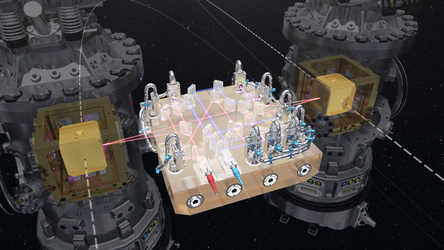
Inside LISA Pathfinder
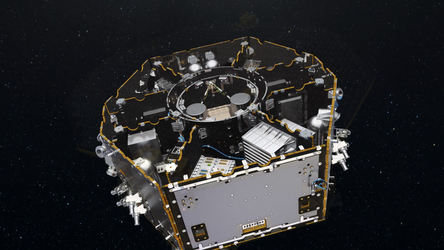
Inside LISA Pathfinder, with narration
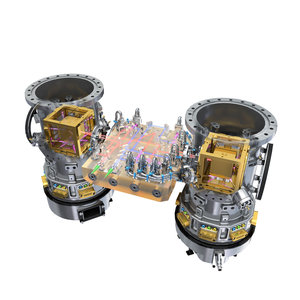
LISA Technology Package
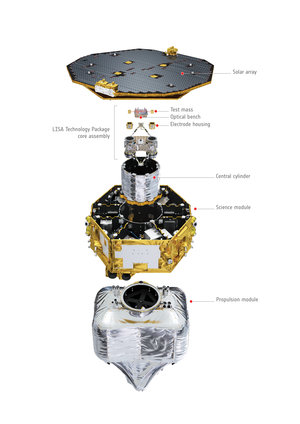
LISA Pathfinder exploded view
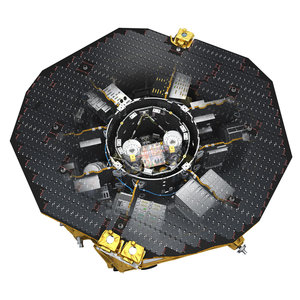














 Germany
Germany
 Austria
Austria
 Belgium
Belgium
 Denmark
Denmark
 Spain
Spain
 Estonia
Estonia
 Finland
Finland
 France
France
 Greece
Greece
 Hungary
Hungary
 Ireland
Ireland
 Italy
Italy
 Luxembourg
Luxembourg
 Norway
Norway
 The Netherlands
The Netherlands
 Poland
Poland
 Portugal
Portugal
 Czechia
Czechia
 Romania
Romania
 United Kingdom
United Kingdom
 Slovenia
Slovenia
 Sweden
Sweden
 Switzerland
Switzerland

























